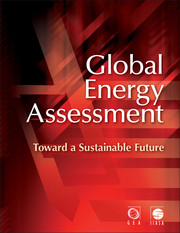Book contents
- Frontmatter
- Contents
- Section 1
- Section 2
- Section 3
- Cluster 1
- Cluster 2
- Cluster 3
- Cluster 4
- Chapter 22 Policies for Energy System Transformations: Objectives and Instruments
- Chapter 23 Policies for Energy Access
- Chapter 24 Policies for the Energy Technology Innovation System (ETIS)
- Chapter 25 Policies for Capacity Development
- Section 4
- Index
- References
Chapter 23 - Policies for Energy Access
Published online by Cambridge University Press: 05 September 2012
- Frontmatter
- Contents
- Section 1
- Section 2
- Section 3
- Cluster 1
- Cluster 2
- Cluster 3
- Cluster 4
- Chapter 22 Policies for Energy System Transformations: Objectives and Instruments
- Chapter 23 Policies for Energy Access
- Chapter 24 Policies for the Energy Technology Innovation System (ETIS)
- Chapter 25 Policies for Capacity Development
- Section 4
- Index
- References
Summary
Executive Summary
A number of factors contribute to the lack of access to modern forms of energy. They include low income levels, unequal income distribution, inequitable distribution of modern forms of energy, a lack of financial resources to build the necessary infrastructure, weak institutional and legal frameworks, and a lack of political commitment to the scaling up of services. An absence of specific policies oriented to poverty alleviation often explains inequitable economic growth and, consequently, inequality in access to and use of energy. In recent years, several developing countries have defined targets aimed at improving access to electricity, but many developing countries still have no modern forms of energy access targets in place that address meeting basic energy services, including modern fuels for cooking and mechanical power.
As Chapter 2 argues, developing countries require adequate access to modern energy, especially among the poor, in order to meet the Millennium Development Goals (MDGs) as well as their own national development objectives. In line with GEA objectives, Chapter 17 pathways are designed to describe transformative changes toward a more sustainable future. A specific feature of the GEA energy transition pathways is that they simultaneously achieve normative goals related to all major energy challenges, including environmental impacts of energy conversion and use, as well as energy security and energy access. ‘Energy access’ refers to those challenges clearly described in Chapter 19, which will be addressed in this chapter.
Affordable and sustainable universal access to modern forms of energy depends on the evolution of income level and income distribution.
- Type
- Chapter
- Information
- Global Energy AssessmentToward a Sustainable Future, pp. 1603 - 1664Publisher: Cambridge University PressPrint publication year: 2012
References
- 2
- Cited by



